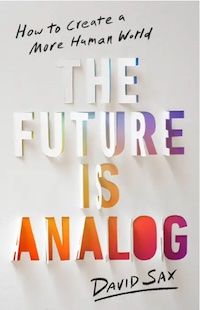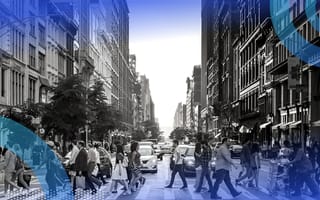The city is transformed. The city is dead. The city is an immaculate living computer, where digital technology links every service, feature, and citizen together. The city is a litter of scattered brick piles and empty office towers, like Detroit in the 1980s. Dirty. Dangerous. Abandoned. Disrupted.
The former, techno-utopic vision for the future of cities has been growing for most of the past century, fueled by constant advances in technology and the imaginations of science fiction writers, architects, urban planners, and inventors. It is frequently referred to as the future city, the data-driven city, the smart city, or the digital city. The dystopian flipside of the coin is the decaying urban jungle. The pandemic brought both those visions into focus. As work, school, and commerce shifted online, we had to confront the fate of cities.
What Is a Smart City?
Cities didn’t die in the pandemic, and any concerns about their future existence were quickly put to rest when they burst back to life the second restrictions lifted. But the panic around the fate of cities worldwide in those early weeks and months revealed a fundamental misunderstanding of what cities are and what they actually need to meet the future.
The smart city promised that our destiny lay in digitizing the city’s infrastructure, but the pandemic revealed a deeper truth about the analog heart of city life.
The Origin of Smart Cities
The origins of the smart city date back to the 1930s and the rise of both automobiles and modernist design, when legendary architects such as Frank Lloyd Wright and Le Corbusier presented their sweeping visions for the future.
Each reflected the aesthetics of its creator, but they shared similar traits, including clusters of identical skyscrapers, broad boulevards and motorways, flying machines and pods, manicured lawns, and ample parking.
In the century since, smart city designs have become more digitally driven but no less idealistic. Each promises to solve the pesky troubles of a city, from traffic and pollution to economic opportunity and citizen safety, by unleashing the latest in digital technology — computers and smartphones, cameras and sensors, flying robots and autonomous vehicles — and feeding reams of data into a central brain of computers that will use statistics and machine learning to solve the intractable problems all cities face.
Over the past decade, municipal governments worldwide have rushed to jump onto the smart city bandwagon, boasting about new data-governance initiatives, cutting-edge blockchain experiments, digital innovation zones built to house technology start-ups, and innumerable press-release-friendly pilot projects, from Wi-Fi kiosks and driverless garbage trucks to park benches with embedded height sensors and flying armadas of specialized drones doing everything from monitoring crowds to delivering pizza.
“When people say innovation in cities, they generally mean an invention . . . something technological and usually the model of something app or Silicon Valley based. This is false and destructive. There are many, many innovative ideas that are not about apps, gadgets, or Silicon Valley.”
If it all looked and sounded like some Epcot ride on the city of the future, well, that was the point.
“Smart Cities are happier cities,” boasted Miguel Eiras Antunes, the global smart city leader at Deloitte, in an article posted on the company’s website last year. “Smart cities use data and digital technology to enhance the quality of life of their citizens. From safer streets to greener spaces, from a reasonable commute to access to art and culture, a smart city creates an environment that promotes the best of urban living and minimizes the hassles of city life.”
Here in Toronto, we saw the arrival of the digital city’s future in 2017, when Sidewalk Labs won a proposal to develop a smart neighborhood along the eastern part of the undeveloped waterfront.
Shoshanna Saxe, a professor of engineering at the University of Toronto’s School of Cities, was skeptical of Sidewalk Labs from the start, but she understood its instant appeal to local politicians, business leaders, and other excited residents. The fundamental problem with pegging the future of cities to digital projects like Sidewalk Toronto is confusing invention and innovation.
“When people say innovation in cities, they generally mean an invention . . . something technological and usually the model of something app or Silicon Valley based,” Saxe said. “This is false and destructive. There are many, many innovative ideas that are not about apps, gadgets, or Silicon Valley.”
Why Analog Solutions Are the Future
True innovation in a city can just as easily be analog, and it often is. A few years ago, during that first visit to Seoul, I was walking with my editor, Taeyung Kang, when we wandered into Samcheong Park, in the hills near the presidential palace. “What’s that?” I asked Taeyung, pointing at a lovely little modern brick-and-wood building nestled beneath the tree canopy. “Oh,” he said, “that’s the forest library.”
The simple building’s interior, outfitted in smooth panels of blond plywood, had a nice selection of books, a café at its center, and a small patio that opened up onto the park.
“Analog is a way of acknowledging how some problems are better solved in a slower way, or a simpler way, or an older way.”
When the forest library opened up, residents and other architects praised [architect Sojin Lee’s] design, hailing it as a healing sanctuary of analog calm in a relentless, frenetic digital city.
“Innovation is something which can influence other people,” Lee said. “That’s what I’m trying to do in my work. It’s nothing spectacular, but the result is often taken as a good example to advance our life. To do projects that do good for other people.”
Technocratic urban beautification schemes, like those of Mike Bloomberg’s New York, inevitably priced out the people living there, dispossessing existing, less-wealthy city dwellers through rapid gentrification in the name of the gilded “progress” that has transformed Manhattan (as well as Toronto, London, and other major cities) into a safe but increasingly sterile sanctuary for the global real estate investment class.
“Analog is a way of acknowledging how some problems are better solved in a slower way, or a simpler way, or an older way,” said Sandra Goldmark, professor of theater at Barnard College and author of Fixation..
These analog innovations aren’t nostalgic. They are solutions firmly focused on the future — not some technocentric version of it, where we invent our way to utopia, but a humancentric future that reflects where we’ve been, what we’ve learned, and how we actually want to live, one that holds particular promise for the future of cities.
Just because someone promises to build a neighborhood for autonomous cars doesn’t mean you can ignore the crumbling roads beneath them or the crowded subway train stuck in a tunnel because the signaling system is underfunded.
Smart Cities, Empty Promises
Beyond the early hype, the actual legacy of smart digital cities is a big old shrug. Almost all of them have either failed, scaled back their promises, or fled town. Some of the earliest, like South Korea’s Songdo, built near the Incheon International Airport, are so empty and quiet, residents openly bemoan how lonely they feel living there. Others, like India’s Dholera, still only exist on paper, despite years of hype and investments.

Burcu Baykurt, who teaches urban futures and communications at the University of Massachusetts, Amherst, is the author of the forthcoming book The City as Data Machine, which looks at the legacy of a smart city project Google and Cisco attempted in Kansas City, starting back in 2016.
The plan was to attempt a testbed downtown, using sensors, advanced cameras, public Wi-Fi networks, and digital kiosks to connect all sorts of city services and improve them for the mostly poorer Black and Latino residents of the area. The data would reveal gaps in parking, transportation, and policing, which would lead to quicker and better solutions by city staff. Baykurt got a front-row seat to what a smart city actually looks like when implemented on the ground.
“To be honest, it doesn’t change much,” Baykurt concluded. “The hype mobilizes a lot of people. There seems to be change going on. Breathless proclamations are made. Articles are written. Politicians take photos with executives. But in the end, the data is just that: lots of data. And in the Kansas City case, the solutions proposed from that data were so impractical and disconnected from reality (driverless cars and drones rather than buses and more police patrols) that the project quietly died after a few years.”
Instead, smart cities offer digital solutions in search of an actual problem. Like one Sidewalk Labs program in Columbus, Ohio, that proposed using driverless cars and ride sharing to bring patients to medical appointments as a solution to persistently high rates of infant mortality in Black neighborhoods, rather than, say, instituting better public transit, education, and prenatal services to improve maternal and infant health in a vulnerable community.
The Future of Cities
A city needs places for people to work and live and shop and eat and meet and have fun and exercise and entertain themselves. It needs good public schools, and ways to get kids and teachers safely to them, and money to pay for all those things. No one ever asked for garbage cans to have sensors in them. They just want the trash to be picked up more often.
“In 2017 everyone said, ‘This is the future in ten years: everything will be smart.’ Well, it’s four years later and nothing is smart, and we still have to deal with actual problems.”
The future of cities lies not in making cities obsolete by upending them through digital utopianism but in doubling down on the analog things that have always made cities great: housing opportunities, economic and cultural diversity, vibrant public spaces, a mishmash of humanity.
“In 2017 everyone said, ‘This is the future in ten years: everything will be smart,’” said Saxe. “Well, it’s four years later and nothing is smart, and we still have to deal with actual problems.”
***
This article has been excerpted from The Future Is Analog: How to Create a More Human World, by David Sax. Copyright © 2022. Available from PublicAffairs, an imprint of Hachette Book Group, Inc.





